Battle of Arcy-sur-Aube - Napoleon's last battle in the 1814 campaign of the year
prehistory
With a huge superiority over the forces of McDonald, Schwarzenberg moved forward extremely slowly. Often only under pressure from the Russian emperor. The insistent decree from Alexander forced the Main Army to advance. At the same time, Schwarzenberg tried to shy away from meetings with Alexander Pavlovich and limit himself to written reports. By 6 (18) March 1814, the army advanced a little beyond the Seine and stretched almost 100 versts from Sans (on Ionne) through Provene, Vilnox, Mary, Arsi to Brienne.
Napoleon 7 and 9 — March 10 fought two battles with Blucher’s army (The feat of the Russian troops in the battle of Kraon, Battle of Laone), but could not break it. The movement of the Main Army to Paris forced the French emperor to again rush to Schwarzenberg’s army. March 16 Napoleon, with an unexpected attack, defeated in Saint-Reims the 14-thousandth Russian-Prussian corps of Count Saint-Prix (Battle of Reims). As a result, Napoleon occupied a central position relative to the Allied armies. The sudden success of Napoleon caused some confusion in the Allied command. Schwarzenberg received a new reason to slow down the pace of the advance of the army. The initiative in the fighting gave the French emperor.
Napoleon's victory at Reims 13 March 1814
Napoleon decided to use a tried-and-true tactic to attack the Main Army of Schwarzenberg, acting not from the front, but against its flank. He hoped to break up the Allied corps scattered on the march and thereby disrupt the attack on Paris. Napoleon, after a three-day rest in Reims, moved his troops to Schwarzenberg. Against the army of Blucher, he left a barrier under the command of Mortier in Soissons and Marmont in Berry-au-Buck. He himself planned to join the 16-17 thousand reinforcements to 11-60 thousands of soldiers, thus connecting up to 18 thousands of people and go to Arsi and Plancy on the right flank of the Main Army. 20 March French troops were already XNUMX versts from Arsi.
But this time the scattered corps of the Main Army was saved by the Russian emperor. Alexander 18 March in 6 hours of the evening came from Troyes in Arsi. Schwarzenberg at this time "sick". “What are you doing? - with displeasure the emperor said to Tolya. “We can lose the whole army.” Immediately, orders were made to concentrate troops towards Arsi. As a result, Napoleon went not to the flank or to the rear of the Allied forces, but to their front.
7 (19) March The main army was located as follows: the corps of Wrede was located in the area of Arsi; behind him, at Brienne, were the Russian-Prussian reserves of Barclay de Tolly. The corps of Crown Prince Wilhelm of Württemberg, Giulai and Rajewski were located partly in Troyes, and some were on the march to this city, near Nogent, Mary and Sans.
Napoleon, having insignificant forces and not knowing about the size of the Main Army, did not dare to attack the enemy on the move. As a result, he did not use the opportunity to overturn the body of Wrede and crash into the center of the allied corps. The French emperor turned to Plancy to connect with Macdonald. Only 8 (20) in March, French troops marched north-east from Plancy along the valley of the River Ob to the town of Arcy-sur-Au. The French cavalry was on the left bank of the river, and the infantry was on the right. By noon, 8 (20) March, the French reached Arsi. This city was located on the left bank of the River Ob. Vanguard Wrede, in order not to be cut off from the main forces there, left Arsi. Cavalry Sebastiani occupied the town.
Battle
8 (20) March. The terrain south of Arsi was crossed by the swampy river Barbusse, it could only be crossed by bridges. Between the river Barbusse and the River Above, resting on the right flank into the River Aube, stood the Corps of Wrede. Guards and reserves were located at the pouches. The corps of the crown prince of Württemberg, Rajewski and Giulai were to arrive from the side of Troyes. Wrede before their arrival received an order not to get involved in a decisive battle. The Allies had at the beginning of the battle about 30 thousand soldiers. Napoleon also expected the arrival of the troops of Oudin and Friant's division, having at the beginning of the battle about 8 thousand people.
The French emperor, suggesting that the Allied forces were retreating towards Troyes, ordered the cavalry of Sebastiani to begin pursuing the enemy. After passing through Arsi, the troops of Marshal Ney took up a position that relied on the left flank on the Brienne road near the village of Great Torcy; and on the right flank, to the village Villet. It housed two cavalry divisions (Colbert and Exelman) under the command of General Sebastiani.
After a long wait, at 2 one o'clock in the afternoon, Schwarzenberg gave the order to attack. At the same time, Napoleon decided that the inaction of the Allied forces meant their willingness to retreat, and moved the troops away from Arsi. The battle began with a Cossack attack by Major General Paisiy Kaysarov on the right wing of Colbert's division. Kaisarov noticed that the enemy artillery was standing with a small cover. At the same time, the hussars of the Archduke Joseph hit the cavalry of Sebastiani. The enemy was overturned by a quick blow, the Allies captured 4 guns. Kohlbero’s left wing attempted to rectify the situation, but was scattered by Austrian artillery firing. The division of Colbert in disarray rushed back and crushed the division of Excelman. The French cavalry fled, shouting: "Save yourself, who can!"
French riders in a panic jump across the city to the bridge. Napoleon personally stood up with his sword on the bridge in Arsi and said: “Let's see who among you dares to go before me!” At this time, the head units of the Old Guard Friant division arrived. Napoleon leads his "grumblers" through the city and builds up into battle order, under a hail of nuclei and grapeshot. It seemed that the emperor was looking for death. One of the grenades tore at his feet. Napoleon disappeared in a cloud of dust and smoke. Everyone thought he was dead. But under Napoleon, only the horse was killed. The French emperor sits on another horse and continues to stand on the front line.
Napoleon in the battle of Arcy-sur-Aube. Engraving by J.-A. Bisse. Mid XIX century
Wrede, seeing the success of the cavalry Kaysarov, decided to throw into battle and the advanced forces of the right flank. The Austrian Volkmann Brigade (5 battalions) was ordered to take the village of Great Torcy. Then the brigade was to hit the city, seize the bridge and thus cut the position of the French army. In addition, the capture of the bridge cut off French troops from reinforcements that could come from the right bank. Two battalions of the 1 Shekler Regiment were to support the Volkman Brigade.
In the center of the attack of the Bavarian troops was stopped by the fire of French batteries. On the right flank the offensive developed better. Volkman Brigade passed the village of Small Torcy and attacked the Big Torcy. The village defended the brigade of Rousseau (division Jansen). Bavarians dropped the enemy from the village and moved to Arsi. Napoleon noticed the threat and reinforced his left flank with two battalions of Guards grenadiers, a gendarme battalion, a lance squadron and one horse battery.
However, even before the arrival of reinforcements, the division in reserve Boye drove the Bavarians out of the village. The commander of the forward battalion, Major Metzen (Metsen), was mortally wounded. General Volkman brought other troops into battle and again captured Big Torcy. For several hours, there was a fierce battle. Napoleon himself arrived at the Great Torcy and encouraged his troops. Wrede, wanting to capture the village, first supported Volkmann with three battalions of the brigade of Prince Karl of Bavaria, and then sent the Gabermann brigade.
Even before the arrival of the Austro-Bavarian reinforcements, Volkmann's troops seized the village for the third time. But they could not develop an attack. The guardsmen of Freean, supported by the divisions of Jansen and Boyer, repulsed Big Torcy. Violent battle lasted until the evening. Fifteen allied battalions under Volkmann, Haberman and Prince Karl's forces broke into the village several times, but their onslaught attacked the brave French troops and they retreated. In this battle, Haberman died, from the French - Zhansen. Both sides suffered heavy losses. Several Austrian battalions shot the entire ammunition and they were taken to the rear.
Already at dusk, the troops of Wilhelm of Württemberg (3, 4 and 6 were under his command) intercepted the French cavalry (two Guards regiments) on the road from Meri to Arsi. Allied cavalry (regiments of Count Palen, 2-I Cuirassier Division, Württemberg and Austrian cavalry) attacked the enemy from several directions. The French squad was almost completely destroyed. Of the 1 ths. Rider, only a few were able to flee. The rest was chopped up or taken prisoner. The three corps of the crown prince of Württemberg only approached the night and did not take part in the battle.
In the evening, the opponents confined themselves to an artillery exchange of fire. The French put out the city to 70 guns and held the Allied cavalry at a distance. Hand-to-hand fight continued only at the Big Torcy. In the evening, the Allied Command began to bring into battle the Russian-Prussian reserves. The detachment of Lieutenant General Choglokova received an order to strengthen the right wing, which attacked Big Torcy. The squad included the 1-I Grenadier Division, the cuirassier brigade of General Levashov (Starodubsky and Novgorod regiments). However, the French kept the village.
In the 9 hours of the evening, reinforcements arrived to Napoleon: the cavalry of Lefebvre-Denuet (2 thousand). The division of the Young Guard of Henrion (4,5 thousand people), tired of forced marches, stopped at Plancy. General Sebastiani, reinforced by the arrival of cavalry, attacked allied cavalry on the left wing at 10 in the evening hours. The Cossacks Kaisarov and the 7 th Bavarian Light Horse Regiment could not withstand the blow and were overthrown. The French seized the Bavarian battery. However, the advance of the enemy cavalry was stopped by the Tauride Grenadier Regiment, which was supported by the Bavarian cavalry. Grenadiers lined up in a square and repelled the attacks of the French before the arrival of the 3 Russian Cuirassier Division. The French were discarded, the battery was beaten off.
At the battle ended. By the evening of March 20, the position of the French army was a semi-circle, the edges of which rested on the r. Oh, and inside was the city of Arsi. At night and in the morning, the advanced units of MacDonald and Oudinot began to approach Napoleon, and his army grew to 25-30 thousand people. The Austro-Bavarian corps of Wrede was on the right flank of the Main Army, in the center were the Russian and Prussian units of Barclay de Tolly, on the left flank were the Austrians of Giulai (Gyulai). They were reinforced by the corps of Württemberg. Each corps allocated one division to the reserve.
The first day of the battle was unsuccessful for the Allied forces: first 8, and then 14 thousands of Frenchmen stopped the blow 30 thousand allies, whose forces by the evening increased to 60 thousand soldiers. Affect the skill and great influence of Napoleon on the soldiers. With his personal presence, the emperor inspired his soldiers, who did not dare to retreat before Napoleon's eyes. Affected and errors of the allied command. Allied forces suffered significant losses: around 800 Bavarians, around 2 thousand Austrians. Losses of Russian troops are unknown. The French lost about 4 thousand people.
Battle Plan for Arsi-sur-Aou 8-9 (20-21) March 1814
9 (21) March. Napoleon, despite the enormous superiority of the Allied Army, planned to attack and hoped to induce a very careful opponent to retreat. On the left wing, at Big Thorse, he deployed Ney's troops (13,5 thousand), in the center was the division of Leval (6,5 thousand people), on the right wing under Sebastiani concentrated all the cavalry (about 10 thousand people).
Schwarzenberg still adhered to cautious tactics, although he already had about 90 thousand soldiers. Justifying the lack of knowledge of the exact number of Napoleon's troops and considering them stronger than they were in reality, the field marshal did not dare to throw an army into the attack, preferring to give the initiative to the enemy. The offensive of the enemy was to show what to do next - to attack with full force, or retreat. Thorsey’s stubborn battle and Sebastiani’s cavalry night attack reinforced his opinion.
In the morning the troops prepared for battle. Napoleon personally conducted a reconnaissance and was convinced of the significant superiority of the forces of the enemy. However, he decided to test the Allied forces for resilience. At 10 hours, Napoleon ordered Sebastiani to attack. Ney had to support him. Sebastiani knocked over the first line of Palen's cavalry, but the second one was stopped.
After that, Napoleon, convinced from the report of Sebastiani and Ney, about the huge superiority of the enemy, decided, without getting involved in the battle, to withdraw the troops beyond the river and go around the allies in the direction of Nancy. First they began to divert the guard, then the divisions of Lefol (formerly Zhansen) and Boye. The troops of Leval and cavalry remained in the rear guard.
The retreat of the French troops and the weakness of their forces were clearly visible from the heights on which stood the main army. It would seem that Schwarzenberg should have attacked the enemy, without losing a single minute, taking advantage of the superiority in the strength and danger of the situation for the French army, when one part of it retreated across the river and the other prepared for retreat. Schwarzenberg convened corps commanders for a “brief” meeting that lasted more than two hours. The Allied command suffered in vain doubts. News came about the discovery of French troops on the flanks. The enemy troops occupied Mary. Some commanders began to fear a detour from the side of the flanks. As a result, the Allies, seeing the plight of the French, missed the opportunity to defeat Napoleon decisively, or at least destroy their rearguard.
The Allied Command remained inactive for several hours while the French withdrawn the troops. Only in 2 hours (according to other information in 3 hours) allied forces began to move. Udino, who led the rearguard, had at his disposal three brigades of the Leval division. The Monforor brigade defended in the eastern suburb, the Molman brigade in the western, the Chasse brigade in reserve. At the newly built bridge at the village Villette team sappers. They had to blow up the bridge, after moving the troops to the right bank.
Count Palen with cavalry of the 6 Corps of Rayevsky attacked the French cavalry, which immediately began to retreat to the Villetto bridge. The French brigade, which retreated to the last line, lost 3 guns and a lot of people captured. The French, under artillery fire and the threat of bypassing the left flank, accelerated the withdrawal. Schwarzenberg ordered Wrede to cross at Lemon on the right bank of the River Ob. Dozens of allied guns crushed the orders of Udino’s troops. The French artillery was forced to shut up and go to the other side. The bridge at Villette was destroyed. Part of the French cavalry, which did not have time to cross, rushed ford, or rushed into the city, crowding and dropping infantrymen into the water.
Oudinot's troops left their positions near the city, and retreated to Arsi, continuing to defend themselves with extreme stubbornness. However, the advantage was on the side of the Allies. Prince Württemberg with the second corps broke into the western suburbs. Corps Giulaya made his way from the south-east side. Austrians and Russians went to the bridge. There was a desperate battle. Leval was injured. Chasse was cut off from the bridge by Austrian arrows, but with hundreds of old soldiers he was able to pave the way for salvation.
With great effort, the remnants of Udi's forces went to the right bank of Oba, after which he followed Napoleon to Vitry. In the evening, MacDonald approached, who brought about 20 thousand soldiers. His troops marched through the marshland, across the gatiyas, so they did not have time for battle.
Austrian infantry in the battle of Arcy-sur-Aube
Results
Allied forces lost about 4 thousand people, including 500 Russians. On the second day of the battle, the losses of the Allied forces were small. The main losses suffered Raevsky corps. Losses of the French are unknown. But over the two days of the battle, more than 2,5 thousand prisoners were captured. Therefore, the losses of the French army were higher (approximately 8 thousand people). This was facilitated by the actions of the Allied artillery.
The actions of Napoleon in this battle were distinguished by desperate audacity, he rushed into battle against a huge number of enemies, without waiting for the arrival of MacDonald's troops. The French emperor was able to halt the attack on Paris by the main army. Part of his calculations were justified. Schwarzenberg again proved to be an indecisive commander or simply did not want to engage in a decisive battle with Napoleon, following the instructions of Vienna to drag out the war. The Allies missed the chance to inflict a decisive defeat on the enemy. However, Napoleon's forces were exhausted, and he could not resist the Allied armies. The outcome of the war was a foregone conclusion.
The Allies agreed on further action and 12 (24) in March approved a plan for an attack on Paris. Against Napoleon, the 10-thousandth cavalry corps was sent under the command of Wintzingerode with the 40 implements, which was supposed to mislead Napoleon regarding the intentions of the Main Army. The armies of Blucher and Schwarzenberg entered into contact with the vanguards and 13 (25) of March moved to the French capital. The Allies defeated the forces of Marshals Marmont and Mortier and the divisions of the National Guard, which were in a hurry to join Napoleon (the battle of Fer-Champenoise). The road to Paris was open. 30 March allies came out to Paris. 31 March Paris capitulated.
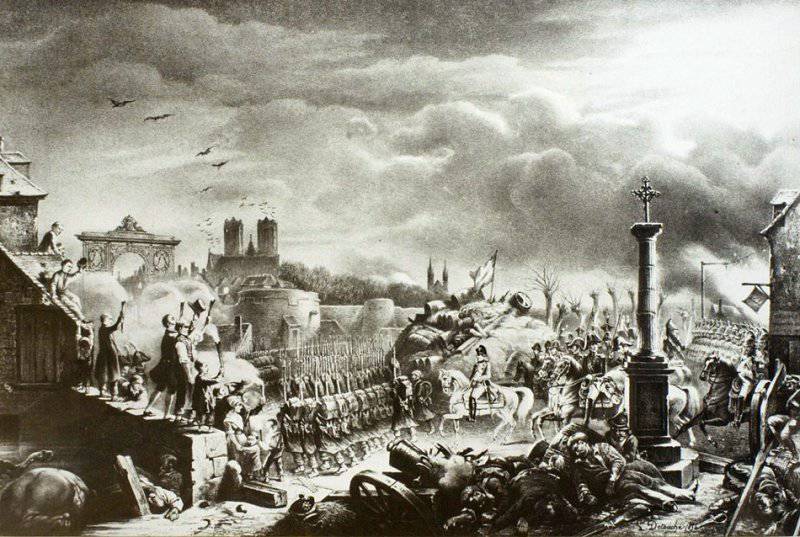
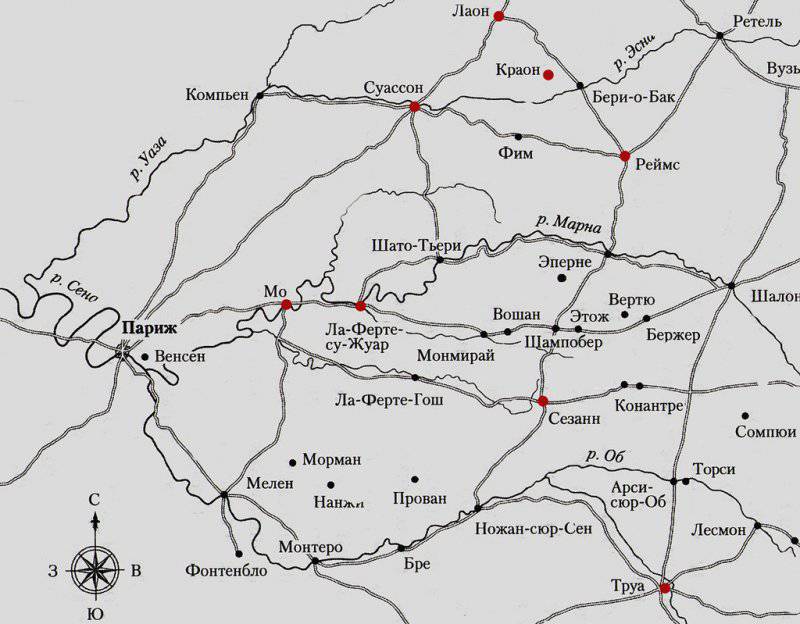
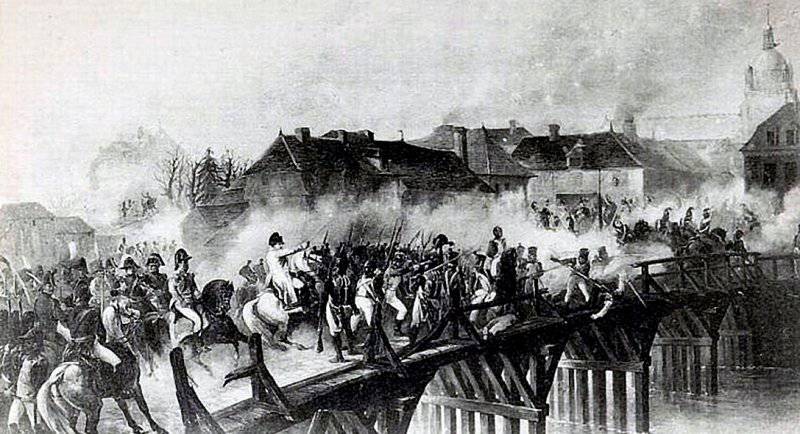
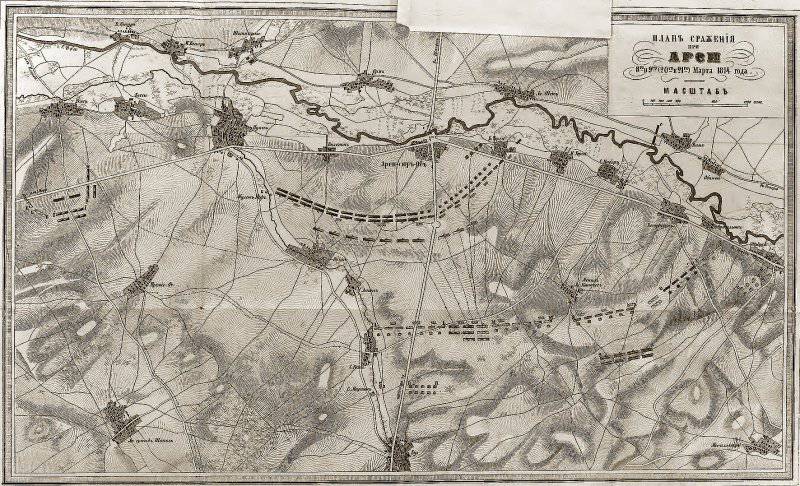
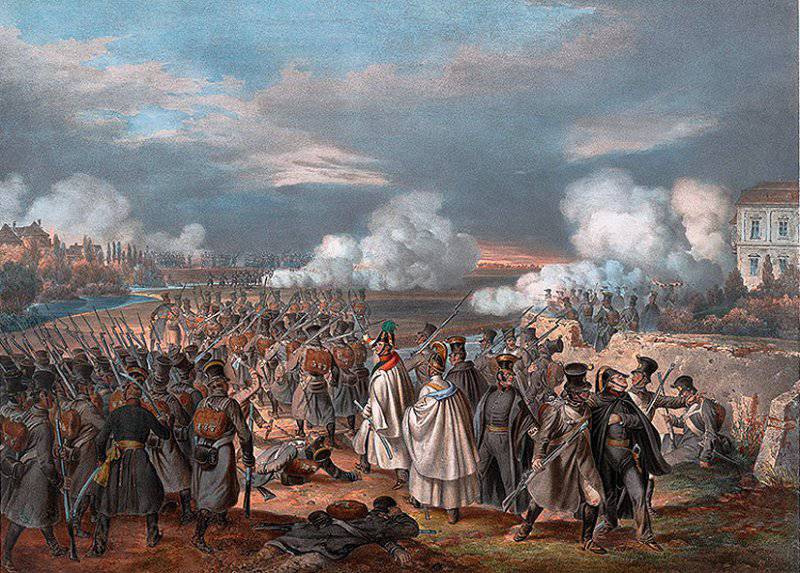
Information